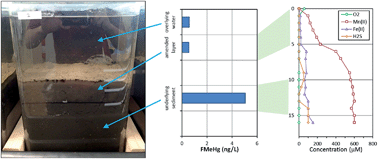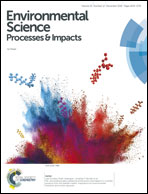Manganese(iv) oxide amendments reduce methylmercury concentrations in sediment porewater†
Abstract
Manganese(IV) oxide (pyrolusite, birnessite) mineral amendments can reduce dissolved MeHg concentrations in sediment theoretically by inhibiting microbial sulfate reduction, which is a major methylation pathway in sediments. Anaerobic sediment slurry microcosms in which Hg methylation was stimulated by addition of labile organic carbon (acetate) and HgCl2 showed that manganese(IV) oxide reduced the percent MeHg in slurry porewater (filtered), by 1–2 orders of magnitude relative to controls. Sediment–water mesocosms with pyrolusite or birnessite either directly mixed into the top 5 cm or applied in a thin (5 cm) sand layer over sediment showed reductions in percent MeHg in porewater of 66–69% for pyrolusite and 81–89% for birnessite amendment. A thin sand layer alone resulted in 65% reduction. CO2 respirometry experiments showed that the amendments stimulated microbial activity. Microbial community census by PCR and DNA sequencing indicated that the addition of Mn(IV) oxides did not significantly alter the indigenous sediment microbial community structure, although a small increase in abundance of iron and manganese reducers was observed after a 2 week incubation period. The mechanism of decreasing MeHg relative to Hg concentrations in porewater likely involved an increase in the importance of Mn(IV) reduction (relative to sulfate reduction) in heterotrophic microbial metabolism in the sediments amended with Mn(IV) oxides. Manganese reduction was confirmed as the predominant biogeochemical redox process by microelectrode voltammetry profiling of the sediment microcosms, although adsorption to Mn oxide surfaces, enhanced MeHg demethylation, and abiotic reduction of Mn(IV) also may have been involved in reducing percent MeHg and suppressing net MeHg production. These results represent a novel approach for mitigating MeHg impacts from sediments with potential applicability to a range of aquatic settings including intertidal zones, tidal marshes, seasonal wetlands, reservoirs, and lakes.

- This article is part of the themed collection: Mercury Biogeochemistry, Exposure, and Impacts


 Please wait while we load your content...
Please wait while we load your content...